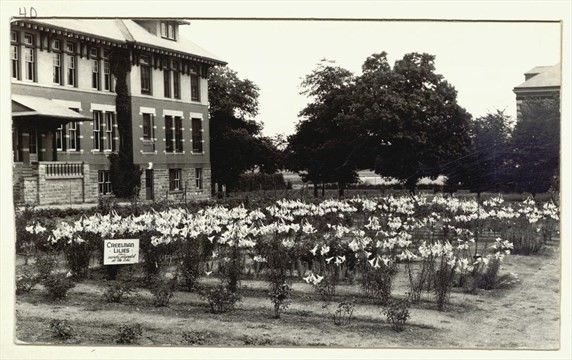In Ottawa, Preston Street is the main vein of the Little Italy neighbourhood. While it's a great place to pick up a cappuccino or pasta dinner, few people know the story of its namesake: Isabella Preston, one of Agriculture and Agri-Foods Canada's (AAFC) original plant breeders.
An English country garden

Isabella Preston poses for a photo c. 1900
Born in Lancaster, England in 1881, Isabella always had green fingers. The child of two avid gardeners, she spent her youth in the family's vegetable garden and planted varieties of flowers from distant lands, as was fashionable in the Victorian era. These new and exotic plants captured the imagination of the young Isabella, sowing the seeds of her future career.
Isabella immigrated to Canada with her sister Margaret in 1912 following the loss of their parents. The intrepid duo arrived in Guelph, Ontario, where Isabella enrolled at the Ontario Agricultural College (OAC), her mind set on a career in horticulture. It wasn't an easy decision: Isabella's friends cautioned her about the challenges of being a woman in a man's world, even in agriculture. Undeterred, she cast aside that advice and followed her passion for plants.
Despite her determination, her tenure at the college was short-lived as she met a professor who changed her life in 1913. Professor J.W. Crow worked in horticulture, raising irises and overseeing many greenhouses and nurseries around Guelph, including at the College. He was in need of an assistant—someone who could maintain and supervise the greenhouses and gardens, and he offered Isabella the position. It was there that her love of plant breeding flourished in earnest. She learned a lot from Professor Crow and studied the finer points of plant breeding by, as she said, "reading all of the books in the library" on the subject.
It was a happy time, but devastation lurked just around the corner and nothing — not even plant breeding — would ever be the same.
A wartime gardener
The First World War began just one year after Isabella started working for Professor Crow. In support of the war efforts, plant breeders were asked to focus exclusively on fast-ripening fruits and vegetables with high yields. Isabella did her part, finding insect and disease resistant varieties for production.
The long lost lily
Isabella Preston's second attempt at the Creelman Lily was a resounding success, going on to win the Award of Merit from the Royal Horticultural Society in 1934. The large, fragrant white flower was the first lily able to withstand the Canadian climate, and plant enthusiasts took great pleasure in cross-breeding it with other varieties. Because of this cross-breeding, the true Creelman Lily has been lost for decades, though many variations continue to thrive in gardens today.
However, her heart was still in the flowerbed. While working diligently to increase food supply during the tumultuous war, she also continued searching for hardy ornamental flowers that could withstand the Canadian climate. She finally succeeded in 1916 by breeding the "Creelman Lily," named after George Creelman, then President of the Agricultural College.
This discovery distinguished Isabella as Canada's first professional female plant breeder. Though the Creelman Lily had a huge setback when all the seedlings were lost in the winter of 1917, the persistent Isabella perfected the lily in 1919. This rebound paved the way for her future — one that would soon see her as instrumental in the history of Canada's ornamental plant breeding.
A blossom in the cold
After the difficult, dark years of the war, the world was in dire need of a morale boost. What better way to find that than in the beautiful flowers of gardens across the country?
Though imported American and European plant varieties could withstand the warmer Canadian regions, Isabella embarked on a mission to create more hardy breeds to survive the northern winters. In 1920, she was hired to do just that at the horticultural division at AAFC's Central Experimental Farm in Ottawa. She began work on a new line of hybrid flowers, and it wasn't long before the eyes of the world were turning once again to the Canadian gardener-extraordinaire.
Lilacs were Isabella's favourite flower, and she bred a line of over 50 hybrid lilacs named after female characters from Shakespeare's plays. These lilacs, along with all of Isabella's ornamental lines, were Canada-hardy, opening up new worlds of colour and form for gardeners in the north.
A life after lilies

A field of Creelman Lilies at the Ontario Agricultural College
Isabella Preston made significant contributions to the long-term beauty of our country and beyond. Several of her hybrids were popular all over the world, including her famous line of "stenographer lilies" named after the seven typists at the Central Experimental Farm's Horticulture Division. This was a poignant gesture to the women who worked hard typing out the research findings at the Central Experimental Farm.
In addition to her work developing beautiful new hybrid flowers for gardeners worldwide, Isabella wrote and lectured extensively on ornamental gardening. She happily shared her knowledge with amateur and experienced gardeners alike and always responded to those seeking her advice. One admiring plant breeder wrote to her: "You are one of my heroes, not only because you have been successful in a line which I should like to be successful, but because of your long record of helpfulness and human sympathy."
When Isabella retired from the Central Experimental Farm in 1946, it came with great sadness but many recognitions. From roses to irises, the queen of ornamental agriculture lives on in our gardens and hearts, keeping the love of beautiful flowers alive. So let's get our hands dirty this spring and pay tribute to Isabella Preston, one of Canada's gardening greats.
Get more Agri-info
- Want more stories like this? Explore what else Agri-info has to offer.
- Interested in reporting on this story? Contact AAFC Media Relations at aafc.mediarelations-relationsmedias.aac@agr.gc.ca to arrange an interview with one of our experts.